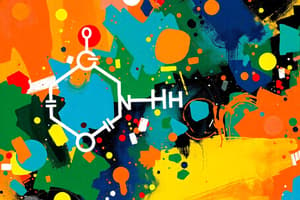Podcast
Questions and Answers
Which alkyl halide is least reactive towards nucleophilic substitution reactions?
Which alkyl halide is least reactive towards nucleophilic substitution reactions?
- 2° alkyl halide
- All are equally reactive
- 1° alkyl halide (correct)
- 3° alkyl halide
What is the stability ranking of carbocations from least to most stable?
What is the stability ranking of carbocations from least to most stable?
- 2° < 3° < 1°
- 1° < 2° < 3° (correct)
- 3° < 1° < 2°
- 3° < 2° < 1°
Which compound is considered the best leaving group?
Which compound is considered the best leaving group?
- Br-
- I- (correct)
- F-
- Cl-
Which type of solvent is best suited for SN1 reactions?
Which type of solvent is best suited for SN1 reactions?
How does crowding of groups affect nucleophilic substitution reactions?
How does crowding of groups affect nucleophilic substitution reactions?
Which of the following methods can produce alkyl halides from alcohols?
Which of the following methods can produce alkyl halides from alcohols?
What characteristic of the C-X bond varies as you move from chloro to iodo derivatives?
What characteristic of the C-X bond varies as you move from chloro to iodo derivatives?
In the preparation of alkyl halides from alkenes, which rule determines the position of halide addition?
In the preparation of alkyl halides from alkenes, which rule determines the position of halide addition?
Which physical property of alkyl halides primarily affects their solubility in water?
Which physical property of alkyl halides primarily affects their solubility in water?
Among the halides CH3F, CH3Cl, CH3Br, and CH3I, which is expected to have the highest boiling point?
Among the halides CH3F, CH3Cl, CH3Br, and CH3I, which is expected to have the highest boiling point?
Which alkyl halide is classified as tertiary?
Which alkyl halide is classified as tertiary?
When adding HBr to an alkene in the presence of organic peroxides, what rule is followed?
When adding HBr to an alkene in the presence of organic peroxides, what rule is followed?
Which option best describes the charge characteristic of alkyl halides?
Which option best describes the charge characteristic of alkyl halides?
How does branching in alkyl halides affect their boiling points?
How does branching in alkyl halides affect their boiling points?
Which mechanism involves a concerted process with inversion of configuration?
Which mechanism involves a concerted process with inversion of configuration?
In the SN1 mechanism, what primarily determines the rate of reaction?
In the SN1 mechanism, what primarily determines the rate of reaction?
Which nucleophiles are considered the strongest based on nucleophilicity trends?
Which nucleophiles are considered the strongest based on nucleophilicity trends?
What is a characteristic of the SN2 reaction mechanism?
What is a characteristic of the SN2 reaction mechanism?
What does the steric factor influence in SN2 reactions?
What does the steric factor influence in SN2 reactions?
Which type of halide is generally more reactive in bimolecular nucleophilic substitution (SN2)?
Which type of halide is generally more reactive in bimolecular nucleophilic substitution (SN2)?
Why do nucleophiles in the SN1 mechanism not affect the rate of reaction?
Why do nucleophiles in the SN1 mechanism not affect the rate of reaction?
Flashcards are hidden until you start studying
Study Notes
Alkyl Halides
- Compounds with halogen atoms bonded to sp³-hybridized carbon.
- General formula: RX or CnH2n+1X (where X = halogens)
- Functional group: X
Alkyl Halides Classification
- Primary (1°): X attached to a primary carbon
- Secondary (2°): X attached to a secondary carbon
- Tertiary (3°): X attached to a tertiary carbon
Alkyl Halides Reactivity
- Nucleophiles: Donate unshared electron pairs to form new covalent bonds.
- Nucleophilic Substitution Reactions: Replace a nucleophile with another.
- Substitution Reactions: Alkyl halides undergo substitution reactions.
- SN2 Mechanism:
- Bimolecular Nucleophilic Substitution
- One-step concerted reaction.
- Nucleophile attacks from the backside.
- Rate depends on both alkyl halide and nucleophile concentrations.
- Inversion of configuration occurs if the nucleophile attacks a chiral center.
- Rate: k[alkyl halide][nucleophile]
- SN1 Mechanism:
- Unimolecular Nucleophilic Substitution.
- Proceeds in two or more steps.
- Forms a racemic mixture if the substitution happens on a chiral center.
- Rate depends only on the alkyl halide concentration.
Factors Affecting Nucleophilic Substitution Reactions
A. Structure of the Nucleophile:
- SN2: Nucleophile's effectiveness is measured by its kinetic study with alkyl halides.
- Nucleophilicity Trend:
- Stronger Nucleophiles:
- OH⁻, OR⁻, RS⁻
- NH2⁻
- CH3O⁻, RO⁻
- Weaker Nucleophiles:
- H2O
- CH3OH
- ROH
- SN1: Nucleophile doesn't participate in the rate determining step.
B. Structure of the Alkyl Halide:
- SN2: Steric hindrance impacts the reaction rate.
- Reactivity Trend: 1° > 2° > 3°
- SN1: Carbocation stability governs the reaction rate.
- Carbocation Stability Trend: 1° < 2° < 3°
- Reactivity Trend: 3° > 2° > 1°
C. Leaving Group:
- The best leaving groups are stable anions.
- Leaving Group Trend: I⁻ > Br⁻ > Cl⁻ > F⁻
D. Solvent:
- SN1: Protic solvents (H2O, alcohols) solvate both anions and cations, favoring SN1 reactions.
- SN2: Aprotic solvents (DMSO, dichloromethane, diethyl ether) are better for SN2 reactions.
Preparation of Alkyl Halides
- From Alkanes: Reaction with Br2 in the presence of UV light or high temperatures yields polysubstituted halides.
- From Alkenes: Halogen acids (HCl, HBr, HI) add to alkenes following Markonikov's rule.
- From Alcohols: Reaction with HBr or HI yields alkyl bromides or iodides.
- Other Methods:
- Reaction with phosphorus halides (PCl5 or PCl3)
- Reaction with thionyl chloride (SOCl2)
Physical Properties of Alkyl Halides
- Gases at room temperature (CH3F, CH3Br, CH3Cl, CH3I) up to C4 are liquids and beyond are solids.
- Insoluble in water but soluble in organic solvents (Don’t form hydrogen bonds with water)
- Boiling points: Increase with increasing London attraction (temporary dipole), influenced by surface area.
- CH3F < CH3Cl < CH3Br < CH3I (increasing boiling point)
Studying That Suits You
Use AI to generate personalized quizzes and flashcards to suit your learning preferences.




